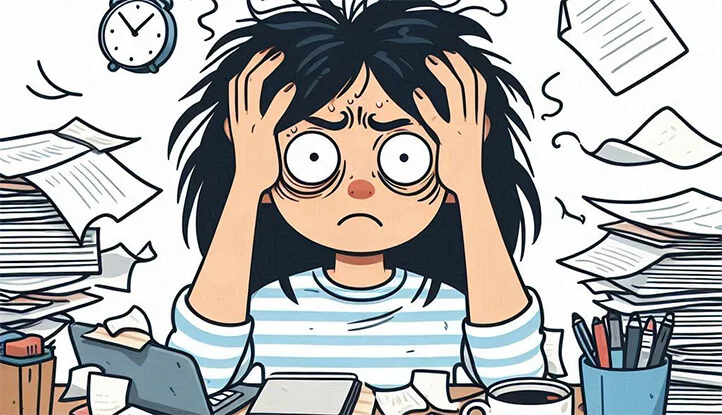Stress has become an integral part of the daily life of a modern person. It is a state of emotional and physical tension that arises in response to demands or situations perceived as excessive or beyond our capabilities. Prolonged stress can negatively impact physical and mental health, triggering sleep problems, weakened immunity, anxiety, and depression.
According to research, about 77% of people regularly experience stress symptoms, including headaches, fatigue, irritability, concentration problems, and muscle tension. Chronic stress increases the risk of cardiovascular diseases, obesity, diabetes, and other serious health issues.
Moreover, stress can significantly reduce work productivity and quality of life. Studies show that employees experiencing high levels of stress make 60% more work-related errors and suffer from a loss of focus and motivation.
It is important to know how to manage stress to maintain well-being and quality of life. This article will cover a comprehensive approach, including physical, psychological, and behavioral strategies, as well as describe specific techniques for reducing stress levels.

Physical Strategies for Stress Management
Regular physical activity, balanced nutrition, sufficient sleep, and relaxation practices are essential components of a stress management program. They help reduce stress hormones, improve well-being, and enhance cognitive functions.
Regular Physical Exercise
Physical activity is one of the best ways to combat stress. During exercise, endorphins are released—hormones that cause a feeling of euphoria and well-being. In addition, physical activity helps relieve accumulated tension and improve sleep.
It is recommended to find time for 30-60 minutes of aerobic exercises (walking, running, swimming, cycling) 3-5 times a week. Strength training and yoga are also beneficial. Outdoor activities are particularly effective for stress reduction due to the additional impact of natural factors. If you cannot attend a gym, simple home workouts will suffice.
It is important to choose a type of physical activity that brings you pleasure and does not become an additional source of stress. It is better to start with light exercises and gradually increase their intensity and duration.
Healthy Eating
A balanced diet rich in…
- whole grains
- fresh fruits and vegetables
- healthy fats (avocados, olive oil, nuts)
- proteins (fish, lean meats, legumes, eggs)
…helps the body cope more effectively with stressful situations. Ensure your diet includes essential vitamins, minerals, and antioxidants.
Foods rich in B vitamins (avocados, bananas, quinoa, tuna) and magnesium (spinach, blueberries, almonds) are particularly beneficial for reducing anxiety and depressive symptoms. Omega-3 fatty acids from fatty fish regulate inflammatory processes in the body, which increase during stress.
Avoid excessive consumption of caffeine, sugar, fast food, soda, and alcohol, as these only exacerbate the problem of stress.
Adequate Sleep
Chronic sleep deprivation sharply raises stress levels and makes a person more vulnerable to its negative effects. Adults are recommended to sleep 7-9 hours a night for full recovery.
Lack of sleep leads to increased fatigue, irritability, poor concentration, and slowed cognitive function. Moreover, it contributes to increased cortisol levels—stress hormone—and reduces insulin sensitivity, which can lead to obesity and diabetes.
Maintain a regular sleep schedule, going to bed and waking up at the same time each day. Create an appropriate sleep environment—sufficient darkness, optimal temperature of 18-22°C, and quiet. Avoid using electronic devices such as smartphones and computers 1-2 hours before bed, as their light disrupts the body’s circadian rhythms.
Before sleep, practice calming techniques—take a warm bath, get a relaxing massage, read a book, or listen to calm music. Avoid intense physical activity and work late in the evening.
If you suffer from chronic insomnia, consult a doctor. The problem may lie in underlying conditions or sleep disorders that require professional diagnosis and treatment.
Breathing Techniques and Meditation
Simple breathing exercises, such as diaphragmatic breathing, help calm down, lower heart rate, and normalize blood pressure in stressful situations. Deep belly breathing activates the parasympathetic nervous system, responsible for the “relaxation” response.
During stress, the body remains in a “fight or flight” state, where heart rate, blood pressure, and muscle tension increase. Consciously slowing your breathing helps restore balance and shift into a state of relaxation and recovery.
Regular meditation practice has also proven effective in reducing anxiety, improving mood, cognitive functions, and increasing stress resilience. There are many types of meditation—mindfulness, visualization, sleep meditation, breath focus, and others. Beginners can try simple breathing meditation techniques or use special apps with audio guides.
It is recommended to meditate for at least 10-15 minutes a day, comfortably seated in a quiet place. In a state of deep relaxation, the brain begins generating alpha waves, restoring inner harmony and balance.
A study conducted at Harvard University showed that just 8 weeks of regular breathing exercises and meditation significantly reduce gray matter density in the brain area responsible for stress and anxiety.

Psychological Strategies
Our thoughts and beliefs play a key role in how we perceive and respond to stressful situations. Learning positive thinking, time management, and emotional regulation can significantly increase stress resilience.
Positive Thinking and Reframing
Negative, catastrophic thoughts only intensify stress, creating a vicious cycle of anxiety and tension. Try to look at a stressful situation from a different perspective, focusing on its positive aspects and opportunities for growth.
Ask yourself questions:
- What can I do to improve the situation?
- How important will this problem be in a year? In 5 years?
- What lessons can I learn from this experience?
- Can I look at what’s happening with a sense of humor?
Maintain an optimistic attitude and focus on solutions rather than problems. Instead of thinking, “This is terrible, I can’t handle it!” try to think, “These are temporary difficulties that will pass. I’ve dealt with similar challenges before.”
It is also helpful to discuss stressful situations with close friends or colleagues. Their outside perspective can provide new insights and help assess the scale of the problems more rationally.
Time Management and Prioritization
The feeling that you can’t complete everything on time is a powerful stress factor. Make realistic task lists for the day and week, prioritizing based on importance and urgency. Don’t take on too many commitments. Learn to say “no” to additional workloads if you feel it’s too much.
It is also useful to use time management techniques:
- time management methods (Pomodoro, 52/17 rule, etc.)
- “two-minute rule”
- delegation of secondary tasks
- setting strict deadlines for important projects
- auditing and reducing time-wasters
Analyze where your time goes and where efficiency can be improved. Include time for important personal matters and rest in your daily schedule.
Clear time management helps combat the stress of constant time shortages and unfinished tasks.
Communication and Social Support
The support of loved ones is very important in stressful situations. Surround yourself with those who are truly ready to listen and empathize, rather than criticize.
Don’t be afraid to ask for help and support when needed. Even simply discussing your problems with friends or family can significantly reduce stress. Keeping everything inside is harmful.
Social isolation worsens stress and depression, so find time for communication and joint activities with close people. Genuine laughter in the company of friends lifts the mood and fills you with positive energy for a long time.
If there’s no one in your immediate circle willing to listen, join support groups with shared interests or problems. A sense of belonging and acceptance has a powerful therapeutic effect.
Hobbies and Rest
Hobbies and interests help distract from problems, recharge, and find new sources of inspiration and joy. Every day, set aside time for activities that bring pleasure and relaxation.
This could be drawing, dancing, crafts, playing a musical instrument, gardening, reading, nature walks, collecting, and much more. Hobbies involving creativity, physical activity, and interaction with nature are the most effective for stress relief.
Creative activities activate the right hemisphere of the brain, responsible for intuition and creativity. This helps switch from constant analysis and rationality to a more relaxed, inspired state.
Regular hobby engagement also boosts self-esteem and a sense of control over your life, which inevitably suffers during stress. Pride in results created with your own hands inspires further achievements.
Make sure to find time for proper rest and recovery. Plan regular vacations and weekends for recharging. Avoid the harmful habit of working without breaks and time off—this leads to burnout.
Create a list of your favorite relaxing activities—spa visits, walks, watching favorite movies, reading, socializing with friends. Strive to maintain a balance between active rest and passive pastimes.

Psychotechnics for Combating Stress
In addition to general strategies, there are specialized psychological techniques proven to be effective in managing stress. They can be used independently or in combination with each other.
Progressive Muscle Relaxation
Progressive muscle relaxation, developed by Dr. Edmund Jacobson, involves tensing and relaxing different muscle groups throughout the body. This helps to identify and release existing physical and emotional tension, as well as develop the skill of deep relaxation.
Progressive muscle relaxation follows this sequence:
- Sit or lie down in a comfortable position.
- Focus on your breathing.
- Begin by tensing various muscle groups for 5-10 seconds, then fully relax them for 10-20 seconds.
- Continue this exercise for all major muscle groups from your face to your feet.
For better results, relaxation can be combined with the visualization of pleasant, relaxing images.
Regular practice of progressive relaxation not only reduces stress levels but also eases symptoms of anxiety, depression, insomnia, and pain syndromes. This technique can be easily learned on your own or by attending specialized courses.
Visualization
Mental imagery is a powerful tool for combating stress and improving well-being. The essence of visualization is to imagine yourself in a calm, peaceful environment using all of your senses.
For example, you can visualize being on a serene tropical beach – feel the warmth of the sun’s rays, hear the sound of the waves, inhale the salty sea air, and so on. Or imagine sitting in a forest clearing, watching the sunlight play and listening to the birds sing.
Research shows that this form of imagined immersion in a relaxing environment activates the same brain regions as in a real situation. With regular visualization, the brain gradually stops distinguishing between reality and imagination.
Visualization lowers stress hormones like cortisol and adrenaline while increasing the production of endorphins, the “pleasure” hormones. It also promotes muscle relaxation, normalizes breathing, and steadies the heart rate.
For the best results, try to engage as many senses as possible, working out the visual images, sounds, smells, and sensations in detail. Find a quiet place and focus on the scene you’re imagining.
Cognitive Behavioral Therapy
Cognitive Behavioral Therapy (CBT) is a scientifically-based psychotherapeutic approach aimed at identifying and correcting negative, destructive thought and behavior patterns that trigger stress and emotional disorders.
At the core of CBT is the belief that our thoughts directly influence emotions, physiological reactions, and behavior. For example, catastrophizing and negative thinking increase stress, while a more balanced, rational view of the situation helps reduce tension.
CBT therapists teach clients to identify unhealthy automatic thoughts (e.g., “I can’t do anything,” “This is terrible”), challenge them with evidence, and replace them with more realistic, adaptive beliefs. Behavioral strategies are also applied, such as gradual exposure to feared stimuli, social skills training, relaxation techniques, and more.
CBT has proven highly effective in treating stress, anxiety disorder, depression, phobias, panic attacks, and many other mental health problems. It can be conducted individually with a therapist or in a group format. There are also books, audio, and video materials for self-study of CBT principles.
Mindfulness Techniques
Mindfulness is a state of being present in the moment and accepting your thoughts and emotions without judgment. Regular mindfulness practice develops the ability to separate the self from the constant internal dialogue, allowing better emotional regulation and reactions to stressful situations.
One of the main mindfulness techniques is breath observation meditation. Sit in a comfortable position and focus on the sensations of inhalation and exhalation. If thoughts arise, gently return your attention to your breath, without getting caught up in thinking.
Other popular practices include body scan meditation, forgiveness meditation, and others. They can be combined with physical exercises, eating, and daily activities to develop sustained mindfulness.
Numerous studies confirm the benefits of regular mindfulness meditation for reducing stress, chronic pain, anxiety, depression, strengthening the immune system, and improving cognitive functions.
Scientists have found that systematic mindfulness practice leads to structural changes in the prefrontal cortex, responsible for decision-making, emotional regulation, and cognitive control. These changes help in better stress management.
Mindfulness also fosters empathy, compassion, and improves relationships with others by promoting greater presence in the moment and openness to new experiences.
Emotional Imagery Therapy
This type of art therapy uses creative self-expression through drawing, collages, poetry, music, dance, and dramatic performances to release and process strong emotions related to stress.
According to the theory, suppressed negative feelings that cannot be expressed accumulate in the subconscious, forming emotional “blocks.” The process of creating artistic images helps safely release and analyze these hidden experiences on a symbolic, non-verbal level.
The advantage of emotional imagery therapy is that it allows access to deep mental resources through the universal language of symbols and metaphors. Creative self-expression stimulates insights, internal healing, and personal growth.
This form of art therapy can be conducted individually under the guidance of a certified specialist or in self-help groups. The group format is particularly valuable, providing a safe environment for expressing emotions and receiving feedback.
During sessions, participants create artworks related to their current experiences and then share their works and feelings with the group. This fosters the development of self-awareness, self-acceptance, and overcoming difficulties.

Lifestyle Changes
To effectively combat stress, along with mastering specific techniques and strategies, it’s important to make general lifestyle and mindset changes.
Reducing Stress Factors
Identify the main sources of stress in your life and take steps to eliminate or minimize their impact. These could be:
- conflicts at work or in the family;
- financial difficulties;
- toxic relationships;
- a lifestyle incompatible with your needs and values;
- poor time and task management.
Create a detailed action plan for managing the identified stressors. Don’t be afraid to let go of harmful habits, break destructive ties, and change established circumstances if they undermine your well-being.
For example, if the main source of stress is a toxic work atmosphere, consider changing your employer. If family conflicts are draining you, seeing a family psychologist might help.
Sometimes difficult life circumstances are inevitable, but you can always choose how you react to them. Accept what you cannot change, and focus on what you can control.
Creating a Routine and Daily Schedule
Having a clear routine and plan of action helps improve productivity and reduce anxiety. Try to wake up and go to bed at the same time, plan the next day’s tasks in the evening.
Allocate enough time to complete tasks, and avoid overloading yourself. Alternate periods of active work with rest, and take relaxation breaks every 60-90 minutes. The schedule should be flexible but within reasonable limits.
During the day, try to focus only on the task at hand, without getting distracted by unrelated matters. This practice helps maintain mental clarity and avoid chaos.
In the evening, review your day’s achievements and mark off completed tasks. The sense of productivity and control over the situation contributes to stress reduction.
Task Delegation and Setting Boundaries
Many people tend to take on too much, trying to control everything themselves. Learn to delegate secondary tasks to colleagues, family members, or hire help when possible.
It’s also important not to allow others to impose an excessive workload on you and to set reasonable boundaries. Master the skill of saying “no” firmly yet politely when you feel overwhelmed. Prioritize personal interests alongside professional and family obligations.
Make a list of tasks and responsibilities that can be avoided or passed on to others without serious consequences. Focus on the most important and priority tasks.
Professional Help
If you experience intense, exhausting stress over a long period and can’t cope on your own, don’t hesitate to seek professional psychological help. A psychologist can help you develop an individualized strategy for overcoming stressful states.

How to Cope with Stress in the Workplace?
The work environment is one of the primary sources of stress for many people. Here are some helpful recommendations:
- Organizing your workspace. Keep your workspace tidy and clean. Minimize clutter and eliminate distractions. Use a filing system for documents and files. All of this will help you focus on tasks and avoid unnecessary chaos.
- Relaxation techniques during breaks. Take short breaks every 60-90 minutes for light stretching and to relieve tension. Practice simple breathing exercises right at your desk. If possible, take short walks outdoors for some fresh air.
- Open communication helps reduce stress levels. Discuss any difficulties you encounter with management and colleagues; don’t keep everything to yourself. In a healthy work environment, you can always find understanding and support.

Conclusion
Coping with stress is an ongoing process that requires attention and effort. Take a comprehensive approach by combining physical practices, psychological strategies, healthy habits, and relaxation techniques. Remember that everyone is unique, and what works for one person may not be as effective for another.
Start applying the knowledge you’ve gained to counter stress today. Over time, you will notice positive changes in your well-being, mood, and overall quality of life. Regularly dedicating time to caring for your physical and mental health is the best path to happiness and inner balance.




